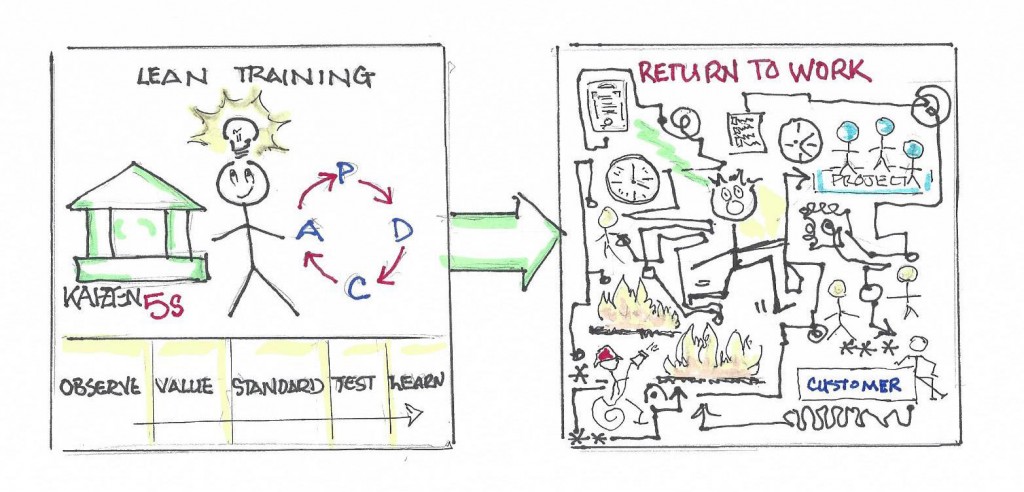Often I have a chance to talk to people who have participated in lean training. The response I get is something like this.
“The training class was great. The ‘aha’ moment hit for all of us. At the close I was so pumped up. When I went to work on Monday I was ready to 5S the world, map our current state, and sit down with my customer to start making both of our businesses better. But after a few weeks the shine dimmed, the enthusiasm dampened in the face of daily pressures, fires to fight, the latest hot priority, and lack of time to do lean. I participated in a kaizen after 3 months. It was great but I still had to return to the real world after. We need something to keep the energy at a high level.”
I also check in with the Lean Program Managers. Training is typically conducted by this group when not done by external resources. Their comments are similar to this.
“The feedback on the training and material is positive. We see the skeptics get it and the leaders in the class light up. But when we follow up with trainees in their real world it seems that the training just doesn’t stick as well as we would like.”
This feedback is consistent from small companies, large companies, old cultures, new cultures, lean beginners, and those on the journey for 10 years. I believe there are two avenues to understand and pursue in studying this problem. One is creating a management system that is conducive to application of lean thinking and tools. The second is to study the transition from classroom lean to real world lean. I would like to offer some thoughts on the second option in this blog.
It is worthwhile to re-examine the process by which lean thinking and tools are transformed into skills and habits after training is completed. A real world model to consider is learning to drive a car. This experience provides a point of reference for transforming lean novices into lean practitioners at work. Most driver education courses have a classroom portion, but no one ever gets a driver license upon completion of classroom training. Even if simulators are provided, real world instruction and practice is required. Post classroom driver training provides structured behind the wheel sessions in a real car that is designed to develop essential safe driving skills. Competence must be certified before a license is issued. Practice, practice, practice is required to develop instinctive habits of safe driving. Finally, parents, insurance companies, and highway patrol officers recognize safe or unsafe acts as appropriate.
Developing a competent lean practitioner after training isn’t very different. When the learner returns to work consider the following suggestions to maximize retention of learning and increased skill application.
Assign a competent lean coach to learners.
The lean coach needs to have skills in basic lean language, processes and tools used in the organization. The lean coach needs to be prepared with:
- A keen interest to see the learner succeed
- Coaching skills
- Knowledge and skill using selected principles and tools
- A coaching plan
- The business context, challenges, and targets the learner will need to deliver
- An application plan developed with the learner
The first 30 days back to work is actually Phase 2 of the training experience.
This is the “student driver” phase of training. Lean application activities may include:
- Direct observation of processes generating quality exceptions or other wastes. Process map observations.
- Identify root cause to observed problems. Select one to improve. Target one improvement daily.
- If 5S is in place, conduct an audit. Improve it. If not in place, implement one 5S project.
- Log daily activities in 15 minute increments for a week. Identify waste points. Eliminate, substitute value added work.
- Assess lean daily management meetings (if conducted). Link to lean thinking and purpose. Improve the meeting you lead.
- Teach the 7 wastes to someone.
Encourage small wins practiced daily as a foundation. Projects may be added to this and may extend timing into an additional 30 days. The coach’s plan has the objective to develop and see the learner demonstrate the targeted skills. The coach and the learner should follow a PDCA habit – plan on Monday, do and check daily, review process and outcomes on Friday. Skills development and focused coaching may be provided for longer periods of time based on the defined targeted competencies to demonstrate.
Key leaders, to include the next level manager, need to engage with the learners.
Key leaders have an integrated role in the success of lean learners after training. Leaders need to be visibly and deliberately involved. Learners need to know their participation is not a coincidence but a planned action. Planned actions may include a mix of process walks that include direct observation and teachable moments. Leaders need to practice and demonstrate lean thinking in the daily routine, role modeling for the team. They need to take the time to ask about the practical application work and coaching sessions to understand what is working and where improvement can happen.
We want to be sure that drivers are competent when they a given a license to drive to protect their own safety and the safety of others. Yes, sometimes lean seems like “common sense.” But changing habits is hard even when learners are willing. Get the first 30-6o days right. Help the learner experience positive improvements from the use of lean. Success breeds success.
Lean Learning Center
The Lean Learning Center was founded in 2001 to address the gaps and barriers that are holding back companies from successful and sustainable lean transformation. In addition to the advanced curriculum, the Center has developed a learning environment designed specifically for adult learning utilizing techniques that include discovery simulations, case studies, personal planning, and reflection – ultimately engaging people at a deep and personal level. We bring our unique lean understanding in creative ways to executives, managers, supervisors, change agents and front-line employees.

